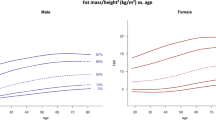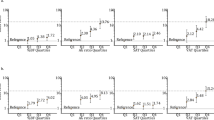Abstract
Background/Objective:
Few studies in Latin American paediatric populations have differentiated fat deposits in specific areas, such as intra-abdominal fat (IAF) and subcutaneous abdominal fat (SAF). Research in diverse populations is needed, as patterns of fat accumulation vary by ethnicity. The aim of this study was to determine whether IAF and/or SAF are related to cardiometabolic risk factors, independent of total body fat (TBF), in a group of Mexican schoolchildren.
Subjects/Methods:
A cross-sectional study was conducted in Mexico City with 94 children aged between 5 and 11 years. IAF and SAF were assessed by magnetic resonance using two different estimation methods: (a) at the midpoint of lumbar vertebras 4 and 5 (L4–L5) and (b) the sum of the areas of four slices (L1–L2, L2–L3, L3–L4 and L4–L5, which will be referred to as ‘total’ IAF and SAF). TBF was measured by dual-energy X-ray absorptiometry. The following cardiometabolic risk factors were assessed: total cholesterol, low-density lipoprotein-cholesterol, triglycerides, glucose, insulin, high-density lipoprotein-cholesterol, blood pressure, insulin resistance, number of risk factors and metabolic syndrome score.
Results:
After adjusting for sex, age and TBF, total SAF was related to the number of cardiometabolic risk factors and metabolic syndrome score. Although IAF at L4–L5 was also related to the number of cardiometabolic risk factors, there was evidence of collinearity with TBF.
Conclusions:
In this sample of Mexican schoolchildren, TBF and SAF, but not IAF, were associated with higher cardiometabolic risk.
This is a preview of subscription content, access via your institution
Access options
Subscribe to this journal
Receive 12 print issues and online access
$259.00 per year
only $21.58 per issue
Buy this article
- Purchase on Springer Link
- Instant access to full article PDF
Prices may be subject to local taxes which are calculated during checkout
Similar content being viewed by others
References
Druet C, Baltakse V, Chevenne D, Dorgeret S, Zaccaria I, Wang Y et al. Independent effect of visceral adipose tissue on metabolic syndrome in obese adolescents. Hormone Res 2008; 70: 22–28.
Katzmarzyk PT, Shen W, Baxter-Jones A, Bell JD, Butte NF, Demerath EW et al. Adiposity in children and adolescents: correlates and clinical consequences of fat stored in specific body depots. Pediatr Obes 2012; 7: e42–e61.
Asayama K, Dobashi K, Hayashibe H, Kodera K, Uchilda N, Nakane T et al. Threshold values of visceral fat measures and their anthropometric alternatives for metabolic derangement in Japanese obese boys. Int J Obes 2002; 26: 208–213.
Asayama K, Hayashibe H, Endo A, Okada T, Hara M, Masuda H et al. Threshold values of visceral fat and waist girth in Japanese obese children. Pediatr Int 2005; 47: 498–504.
Owens S, Gutin B, Ferguson M, Allison J, Karp W, Le N-A . Visceral adipose tissue and cardiovascular risk factors in obese children. J Pediatr 1998; 133: 41–45.
Slyper AH, Rosenberg H, Kabra A, Huang W, Blech B, Matsumura MM . Fatty liver disease, glucose tolerance and insulin resistance in obese adolescents. Pediatr Obes 2015; 10: 423–427.
Goran MI, Lane C, Toledo-Corral C, Weigensberg MJ . Persistence of pre-diabetes in overweight and obese Hispanic children association with progressive insulin resistance, poor beta-cell function, and increasing visceral fat. Diabetes 2008; 57: 3007–3012.
Staiano AE, Katzmarzyk PT . Ethnic and sex differences in body fat and visceral and subcutaneous adiposity in children and adolescents. Int J Obes 2012; 36: 1261–1269.
Gower BA, Nagy TR, Goran MI . Visceral fat, insulin sensitivity, and lipids in prepubertal children. Diabetes 1999; 48: 1515–1521.
Fernández JR, Redden D, Pietrobelli A, Allison D . Waist circumference percentiles in nationally representative samples of African-American, European-American, and Mexican adolescents. J Pediatr 2004; 145: 439–444.
Casazza K, Dulin-Keita A, Gower BA, Fernandez JR . Intrabdominal fat is related to metabolic risk factors in Hispanic Americans, African Americans and in girls. Acta Paediatr 2009; 98: 1965–1971.
Brambilla P, Bedogni G, Moreno LA, Goran MI, Gutin B, Fox KR et al. Crossvalidation of anthropometry against magnetic resonance imaging for the assessment of visceral and subcutaneous adipose tissue in children. Int J Obes 2006; 30: 23–30.
Maligie M, Crume T, Scherzinger A, Stamm E, Dabelea D . Adiposity, fat patterning, and the metabolic syndrome among diverse youth: the EPOCH Study. J Pediatr 2012; 161: 875–880.
Ortiz-Henández L, López NP, Gómez G, Melchor DP, Váldes J . Application of body mass index to schoolchildren of Mexico City. Ann Nutr Metab 2008; 53: 205–214.
Sundquist J, Winkleby MA . Cardiovascular risk factors in Mexican American adults: a transcultural analysis of NHANES III, 1988–1994. Am J Public Health 1999; 89: 723–730.
De Onis M, Onyango AW, Borghi E, Siyam A, Nishida C, Siekmann J . Development of WHO grown reference for school-aged children and adolescents. Bull WHO 2007; 85: 660–667.
Rasband WS ImageJ, Image Proccesing and Analysis in Java. US National Institutes of Health: Bethesda, MD, USA, 1997–2012.
Winsley RJ, Fulford J, MacLeod KM, Ramos-Ibanez N, Williams CA, Armstrong N . Prediction of visceral adipose tissue using air displacement plethysmography in children. Obes Res 2005; 13: 2048–2051.
Hangartner TN, Warner S, Braillon P, Jankowski L, Shepherd J . The Official Positions of the International Society for Clinical Densitometry: acquisition of dual-energy X-ray absorptiometry body composition and considerations regarding analysis and repeatability of measures. J Clin Densitom 2013; 16: 520–536.
Bosch TA, Dengel DR, Kelly AS, Sinaiko AR, Moran A, Steinberger J . Visceral adipose tissue measured by DXA correlates with measurement by CT and is associated with cardiometabolic risk factors in children. Pediatr Obes 2015; 10: 172–179.
Peplies J, Jimenez-Pavon D, Savva SC, Buck C, Gunther K, Fraterman A et al. Percentiles of fasting serum insulin, glucose, HbA1c and HOMA-IR in pre-pubertal normal weight European children from the IDEFICS cohort. Int J Obes 2014; 38: S39–S47.
Barba G, Buck C, Bammann K, Hadjigeorgiou C, Hebestreit A, Marild S et al. Blood pressure reference values for European non-overweight school children: the IDEFICS study. Int J Obes 2014; 38: S48–S56.
De Henauw S, Michels N, Vyncke K, Hebestreit A, Russo P, Intemann T et al. Blood lipids among young children in Europe: results from the European IDEFICS study. Int J Obes 2014; 38: S67–S75.
Ahrens W, Moreno LA, Marild S, Molnar D, Siani A, De Henauw S et al. Metabolic syndrome in young children: definitions and results of the IDEFICS study. Int J Obes 2014; 38: S4–S14.
Lohman TG, Roche A, Martorell R Anthropometric Standardization Reference Manual. Human Kinetics Books: Champaing, IL, USA, 1988, p 90.
Akobeng A . Understanding diagnostic tests 3: receiver operating characteristic curves. Acta Paediatr 2007; 96: 644–647.
Kursawe R, Eszlinger M, Narayan D, Liu T, Bazuine M, Cali AM et al. Cellularity and adipogenic profile of the abdominal subcutaneous adipose tissue from obese adolescents: association with insulin resistance and hepatic steatosis. Diabetes 2010; 59: 2288–2296.
Tchernof A . Visceral adipocytes and the metabolic syndrome. Nutr Rev 2007; 65: S24–S29.
Frayn KN . Adipose tissue as a buffer for daily lipid flux. Diabetologia 2002; 45: 1201–1210.
Coles CA . Adipokines in healthy skeletal muscle and metabolic disease. Adv Exp Med Biol 2016; 900: 133–160.
Fox KR, Peters DM, Sharpe P, Bell M . Assessment of abdominal fat development in young adolescents using magnetic resonance imaging. Int J Obes 2000; 24: 1653–1659.
Harrington DM, Staiano AE, Broyles ST, Gupta AK, Katzmarzyk PT . Waist circumference measurement site does not affect relationships with visceral adiposity and cardiometabolic risk factors in children. Pediatr Obes 2013; 8: 199–206.
Demerath EW, Sun SS, Rogers N, Lee M, Reed D, Choh AC et al. Anatomical patterning of visceral adipose tissue: race, sex, and age variation. Obesity 2007; 15: 2984–2993.
McLaughlin T, Lamendola C, Liu A, Abbasi F . Preferential fat deposition in subcutaneous versus visceral depots is associated with insulin sensitivity. J Clin Endocrino Metab 2011; 96: E1756–E1760.
Tchernof A, Després J-P . Pathophysiology of human visceral obesity: an update. Physiol Rev 2013; 93: 359–404.
Després J-P, Lemieux I, Prud'homme D . Treatment of obesity: need to focus on high risk abdominally obese patients. BMJ 2001; 322: 716–720.
Instituto Nacional de Estadística y Geografía Censo de Población y Vivienda 2010. Cuestionario básico. Instituto Nacional de Estadística y Geografía: Aguascalientes, Mexico, 2011.
Acknowledgements
We are grateful for the support of Magdalena Rodriguez-Magallanes from the Nutrition, Body Composition and Energy Expenditure Unit, who standardized the observer who performed the anthropometric measurements. We are also grateful for the collaboration of Diana Pérez-Salgado (who provided technical support for dual-energy X-ray absorptiometry measurements), Joana Cázares-Lara and Joab Medina-Gómez, who collaborated in doing the fieldwork. GAC received a scholarship from the CONACyT to complete her doctoral and master degree studies. OHL received supplementary support from the CONACyT as National Researcher (project no. 119134).
Author information
Authors and Affiliations
Corresponding author
Ethics declarations
Competing interests
The authors declare no conflict of interest.
Rights and permissions
About this article
Cite this article
González-Álvarez, C., Ramos-Ibáñez, N., Azprioz-Leehan, J. et al. Intra-abdominal and subcutaneous abdominal fat as predictors of cardiometabolic risk in a sample of Mexican children. Eur J Clin Nutr 71, 1068–1073 (2017). https://doi.org/10.1038/ejcn.2017.28
Received:
Revised:
Accepted:
Published:
Issue Date:
DOI: https://doi.org/10.1038/ejcn.2017.28
This article is cited by
-
Associations of plasma 8-iso-prostaglandin F2αlevels with fasting blood glucose (FBG) and intra-abdominal fat (IAF) area in various Glycometabolism populations
BMC Endocrine Disorders (2021)
-
Sex-based differences in phagocyte metabolic profile in rats with monosodium glutamate-induced obesity
Scientific Reports (2018)



